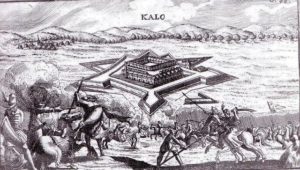13 January 1575: The clash at Böszörmény
In the early 1570s, to strengthen the eastern frontier and keep an eye on Transylvania, the construction of the Kálló fortress began, and the young Prépostváry Bálint was appointed its captain. He was charged with the task of fortifying the castle, which Prépostváry carried out with great energy.

He also regularly led raids in the area, for which he received constant complaints from the Buda Pasha to the Court Military Council in Vienna and King Maximilian. In 1574, Mustafa Pasha wrote: ‘From Kálló, where all the rabble lives, the Turks are suffering many blows’. From this, we can conclude that Prépostváry and his soldiers wasted no time. They also attacked the market of Fegyvernek, but then they were defeated.

However, on 13 January 1575, the captain wrote:
“Last time, four times as many Turks were beaten by ours as by the garrison of Kálló. But the attacker was the Turk. The forty Hajdú warriors of Farkas Márton were indeed routed by the Turks, but Farkas Márton is not serving at Kálló. It is also true that the Bey of Szolnok came out with his army, but 100 horsemen from Kálló and 40 Hajdú infantrymen, with God’s help, thwarted his evil plan. When the Turks attacked Böszörmény, they rounded up many men (to sell them as slaves, my note) and headed for home with the booty, our people crushed them. It was in this bloody battle that my captain from Kálló, Sidy János, a battle officer of unparalleled valour, fell, heroically fighting and losing six of his men”. In February, Mustafa was already demanding the destruction of Kálló. The clash, which ended in a Hungarian victory, is the starting point of the novel “The Captain of Kálló” by Gulácsy Irén.

Prépostváry continued to hold his castle firmly and, as he wrote, even recaptured 2-300 villages. This also shows the importance of the role of a fortress in holding the area. The battle of Böszörmény was not a significant military achievement in itself, but it does highlight the valor of the Hungarian garrison, who were able to gain victory in the face of multiple outnumbering and thus keep the Hungarian population intact.
19 October 1575: the warriors of Kanizsa castle laid a trap

These “traps” (in Hungarian they were called “les”, meaning “ambuscade”) took place every day along the 1,000-mile border between the Ottoman Empire and Royal Hungary. Luring the enemy into a trap with the help of a “bait” (“martalék”), i.e. sending a few horsemen forward to lead the enemy to the place of ambush, was practiced by both the Hungarians and the Ottomans. Here is more about the Borderland:
https://www.hungarianottomanwars.com/essays/the-borderland/

The Borderland was not only defended by its castles and forts: as the saying goes, “a castle can only be defended in the field”. And that meant constant cavalry raids and patrols. It was mobile warfare that kept Europe’s frontiers open for generations. At the same time, these raids were driven by a lack of money. If the hussars were to avoid starvation, they had to take valuable prisoners for ransom. All the booty was divided into three parts: a share for the king, a share for the families of the fallen warriors, and a share for the soldiers. It was a rather strict rule among the Order of the Valiant members.

Again, these were mostly unrecorded military actions. In the picture above, you can see 16th-century Hungarian winged hussars bringing home Ottoman heads. Note that this grim custom was practiced by Ottoman Turks and Hungarians alike. The Habsburg kings paid gold for these trophies, as did the Ottoman sultans. A head was worth about a month’s pay for a soldier. Below, you can see the picture of Kanizsa Castle in the 16th century, designed by Pazirik Kft.

More about the Castle of Kanizsa:
https://www.hungarianottomanwars.com/ottoman-occupied-lands/kanizsa/
I dare say that these clashes of the ‘small war’ were just as important as the glorious victories or heroic last stands because they responded to the Ottoman strategy of ‘softening up’ a region. The enemy used this very effectively: they destroyed, burned, and looted the region around a Hungarian/Croatian castle, terrorizing the peasants in the area. They either died or fled, and the castles became isolated, no one came to bring taxes or food from the neighborhood, and no one came to work on the walls. Sooner or later these castles would fall to the Turks, who would move on to conquer the next region or valley. This had to be stopped, and the Hussar cavalry was the perfect way.

According to Szibler Gábor, the Hungarian border guards of Kanizsa Castle set out and rode after an Ottoman cavalry unit that was plundering the neighborhood.
As it had snowed that night (in October!), they could easily track them. So they rode on and set a trap for the Turks who ran into it. After a fierce battle, the enemy was defeated.
Among the Hungarians were some hussars from Kiskomárom Castle, who got 6 prisoners from the bounty. The horsemen from Kanizsa took 29 armoured Ottoman Sipahies as prisoners and other booty, including 40 horses.

Source: Szibler Gábor
Dear Readers, I can only make this content available through small donations or by selling my books or T-shirts.
If you like my writings, please feel free to support me with a coffee here:
You can check out my books on Amazon or Draft2Digital, they are available in hardcover, paperback, or ebook:
https://www.amazon.com/dp/198020490X
or at https://books2read.com/b/boYd81


My work can also be followed and supported on Patreon: Become a Patron!http://Become a Patron!


https://hungarianottomanwars.myspreadshop.com/

https://hungarianottomanwars.myspreadshop.com/all


